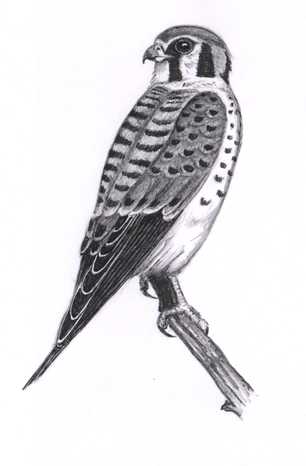
Dear Bird Folks:
Where have all the Sparrow Hawks gone? It seems like only a few years ago I would see one everyday, but now I rarely see them. Has something happened to them?
– Lenny, Wellfleet
Hey Lenny,
I think you must have missed a meeting. There hasn’t been a bird called “Sparrow Hawk” for about five decades. Years ago somebody realized that Sparrow Hawks, amazingly enough, were falcons, not hawks at all, and that they didn’t eat all that many sparrows. So they quickly changed the name to American Kestrel hoping nobody would notice. Of course everyone did notice. Well, almost everyone. Evidently news travels slowly to the Outer Cape.
The American Kestrel is truly a handsome bird. It is by far our most colorful bird of prey. Only about the size of a robin, it is our smallest falcon and a sweet little bird. Well, sweet if you can call a bloodthirsty predator sweet.
During the warmer months they mostly eat large insects such as beetles and grasshoppers. Kestrels often hunt insects from power lines, where they like to sit waiting to pounce at the slightest movement. Kestrels also have the ability to hoover like kingfishers. Quick wing flapping enables them to scope out an entire field by hanging in mid air.
Your observations are correct, Lenny, our kestrel population has been dropping. Ten or twenty years ago, it was hard to go for a walk without seeing a kestrel and now they are rarely seen in these parts. The two major reasons for the decline appear to be habitat change and an increase of hawks.
Kestrels thrive in open fields. In recent years many farms and orchards have been replaced with houses or allowed to become overgrown with trees. Some birds love trees, while some birds depended on open areas. Without open fields kestrels have no place to hunt.
Hawks appear to be another problem. A recent increase of breeding and wintering hawks, particularly Cooper’s Hawks, who eat kestrels, may have forced kestrels to move on or be on the menu.
In addition, kestrels don’t have the skills to build their own nests. Like bluebirds, kestrels are secondary cavity nesters. They need to find an old woodpecker hole or a nest box in order to breed. Winter storms and our paranoia of dead trees has eliminated many potential nesting sites. Fortunately kestrels will use man made nest boxes. Hey, that could be a good winter project for you, Lenny. Goodness knows there isn’t much else going on in Wellfleet that time of year.
Sometimes using old woodpecker holes can get these birds into trouble. Years ago, while I was taking a fall bird walk through the hills of North Truro, I came upon an old abandoned house with a kestrel trapped inside. It was a spooky looking house, that was full of woodpecker holes. Somehow this kestrel managed to enter this house through one of the many holes and couldn’t find a way out. I could see the bird, way up on the second floor flying from room to room, from window to window, trying to escape. I knew right away that I had to find a away into this creepy old house or the bird was a goner. Getting in was easy-the back door was not locked. Not even crooks would dare enter this eerie place. Once inside I quickly raced upstairs (why is it always upstairs?) and opened all the windows. Seeing the open window the kestrel instantly flew to freedom, never once looking back to see if I made it out all right. Another ungrateful predator.
Even though there are a few regions where the kestrel population has crashed, overall their population is doing fairly well. Hopefully we are just experiencing a temporary drop and some day soon the kestrels will return to our area. In the meantime, putting a few nest boxes up for them is about the best you can do. Oh yeah, learning the bird’s correct name might be a good idea too.